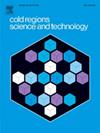Physical test and numerical simulation study of ice-bridge piers interaction
IF 3.8
2区 工程技术
Q1 ENGINEERING, CIVIL
引用次数: 0
Abstract
In cold regions, the formation and movement of ice sheets around bridge piers over reservoirs can pose a significant threat to the safety of the structure by imposing a considerable static ice load. This paper takes the bridge pier frozen in the ice sheet as the research object, carried out the static ice load physical test of the interaction between the ice sheet and the bridge pier, and investigates the structural response under different ice sheet thicknesses, different bridge pier cross-section form, and different displacement rate. Additionally, a numerical simulation method, including cracking, was proposed for comparative verification of the test results. The conclusions of the study are as follows: As the ice sheet thickness increased in the test, the extrusion crushing area of the ice sheet became more extensive, with more cracks and longer extensions, accompanied by the intersection of ring cracks and vertical cracks. In square bridge pier tests, initial cracks in the ice appeared at the corner of the bridge pier on the tension side. In circular bridge pier tests, initial cracks appeared on both sides perpendicular to the forward direction of the pier. The peak loads of the numerical model considering the adfreeze were in good agreement with the physical test results, and the peak loads without considering the adfreeze were in good agreement with the current codes. The model considering the adfreeze had a broader range of cracks, and the cracks extended longer. The peak loads considering the adfreeze are proportional to those without considering the adfreeze, and the proportions differ for circular and square piers. Both the test results and the numerical modelling results show that the ice forces are greater with adfreeze present. Load values calculated from the current code (China 2016) are lower than the measured loads and from the numerical model with adfreeze present. Suggestion factors of 1.64 and 1.48 for circular and square piers respectively are proposed when adfreeze is present.
求助全文
约1分钟内获得全文
求助全文
来源期刊

Cold Regions Science and Technology
工程技术-地球科学综合
CiteScore
7.40
自引率
12.20%
发文量
209
审稿时长
4.9 months
期刊介绍:
Cold Regions Science and Technology is an international journal dealing with the science and technical problems of cold environments in both the polar regions and more temperate locations. It includes fundamental aspects of cryospheric sciences which have applications for cold regions problems as well as engineering topics which relate to the cryosphere.
Emphasis is given to applied science with broad coverage of the physical and mechanical aspects of ice (including glaciers and sea ice), snow and snow avalanches, ice-water systems, ice-bonded soils and permafrost.
Relevant aspects of Earth science, materials science, offshore and river ice engineering are also of primary interest. These include icing of ships and structures as well as trafficability in cold environments. Technological advances for cold regions in research, development, and engineering practice are relevant to the journal. Theoretical papers must include a detailed discussion of the potential application of the theory to address cold regions problems. The journal serves a wide range of specialists, providing a medium for interdisciplinary communication and a convenient source of reference.
 求助内容:
求助内容: 应助结果提醒方式:
应助结果提醒方式:


